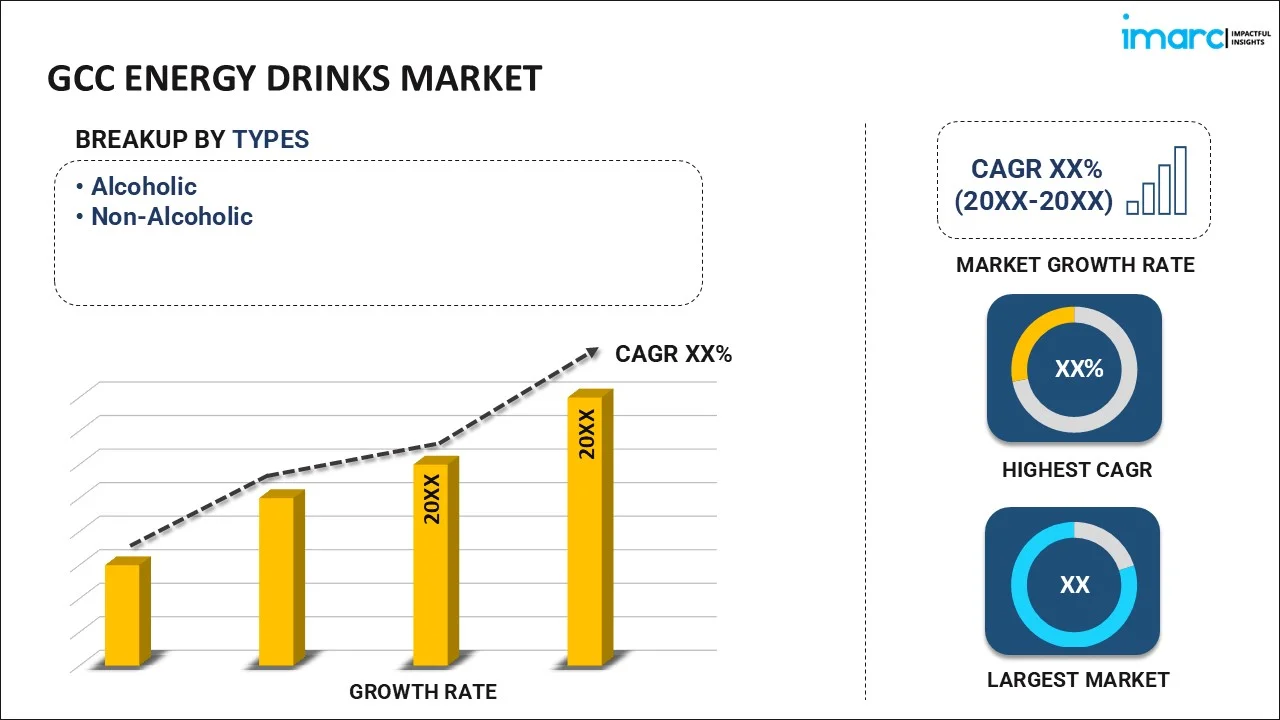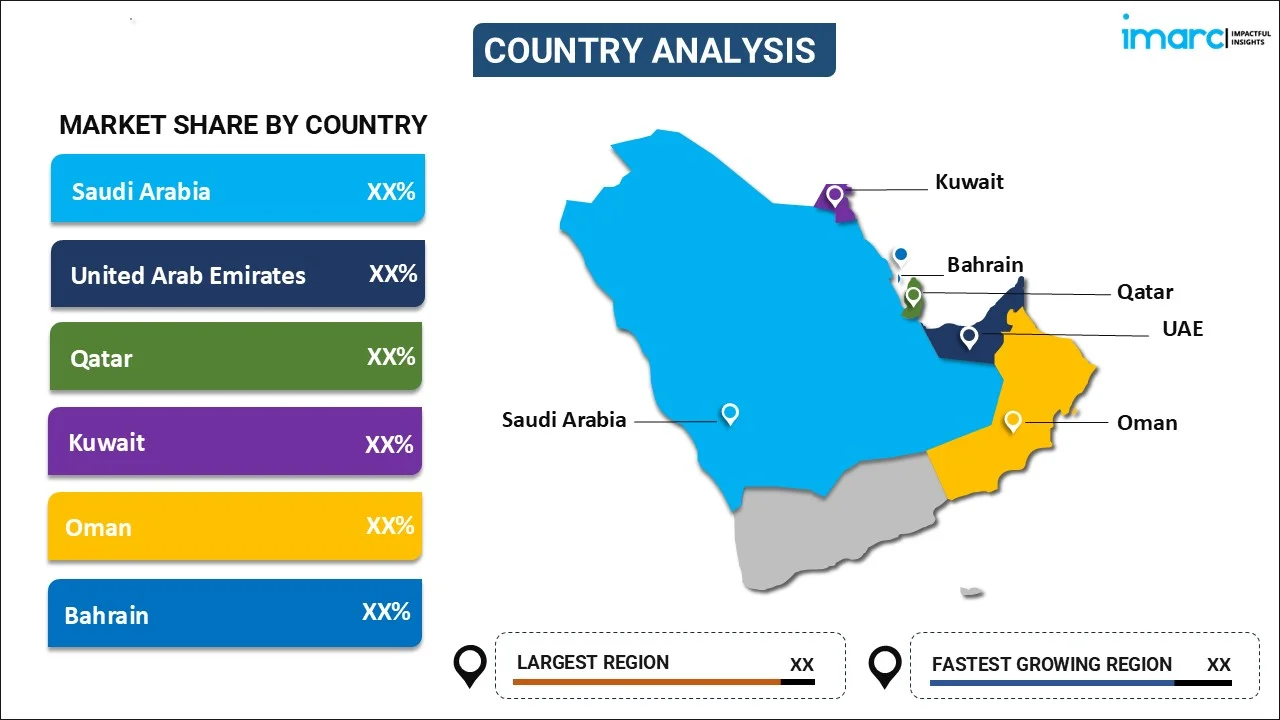
GCC Energy Drinks Market Report by Type (Alcoholic, Non-Alcoholic), End User (Kids, Adults, Teenagers), Distribution Channel (Supermarkets and Hypermarkets, Specialty Stores, Convenience Stores, Online Stores, and Others), and Country 2025-2033
Market Overview:
The GCC energy drinks market size reached USD 817.2 Million in 2024. Looking forward, IMARC Group expects the market to reach USD 1,717.1 Million by 2033, exhibiting a growth rate (CAGR) of 8.2% during 2025-2033. The rising fitness and wellness trend encouraging a shift in consumer behavior, the introduction of organic and natural energy drinks, and the growing health consciousness among the masses are some of the key factors driving the market.
|
Report Attribute
|
Key Statistics
|
|---|---|
|
Base Year
|
2024
|
|
Forecast Years
|
2025-2033
|
|
Historical Years
|
2019-2024
|
|
Market Size in 2024
|
USD 817.2 Million |
|
Market Forecast in 2033
|
USD 1,717.1 Million |
| Market Growth Rate 2025-2033 | 8.2% |
Energy drinks are non-alcoholic beverages specifically formulated to deliver mental and physical stimulation for short periods of time. They contain key ingredients such as caffeine, taurine, vitamins, and other stimulants, which work in tandem to provide a quick energy boost. These beverages are designed to meet the needs of individuals seeking instant energy to combat fatigue and improve performance, making them popular among athletes, students, and professionals. They have a high caffeine content that helps with alertness while also giving you a quick boost of energy from the sugar. Meanwhile, taurine, an amino acid, along with the various B vitamins, is intended to support the body's metabolism and sustain energy production. The commercial promise of these products lies in their ability to cater to modern, fast-paced lifestyles, offering an instant recharge amid hectic routines. The appeal of energy drinks lies in their convenience and portability. They are packaged in cans or bottles, making them easy to carry and consume on the go. This convenience makes them popular among individuals with busy and demanding lifestyles, such as athletes, students, and professionals who may need a quick energy boost to combat fatigue and improve performance.
GCC Energy Drinks Market Trends:
The rising youth demographic, which represents a key consumer segment for energy drinks, majorly drives the market. With their active lifestyles and inflating disposable income, young consumers are driving growth in this market. Similarly, urbanization and the associated shift towards quick-paced lifestyles have increased the need for products offering convenience and immediate results, such as energy drinks. Moreover, the rising fitness and wellness trend in the GCC region has promoted a shift in consumer behavior, encouraging the intake of energy drinks as part of pre- or post-workout routines. In response, manufacturers are introducing variants with added health benefits and less sugar, catering to health-conscious consumers. In addition to these drivers, various market trends are influencing the landscape of the GCC energy drinks market. Along with this, the support for healthier product offerings has given rise to the introduction of organic and natural energy drinks, resonating well with consumers seeking healthier alternatives. Concurrently, innovative packaging and marketing strategies adopted by key players in the sector are enhancing product visibility and brand recall. Apart from this, regulatory bodies in the region are introducing stringent regulations related to the content and labeling of energy drinks, indirectly shaping the market dynamics. Furthermore, the escalating penetration of online retail in the region is allowing energy drink manufacturers to reach a wider audience, thus stimulating the overall market growth in the GCC region.
GCC Energy Drinks Market Segmentation:
IMARC Group provides an analysis of the key trends in each segment of the GCC energy drinks market report, along with forecasts at the regional and country levels for 2025-2033. Our report has categorized the market based on type, end user and distribution channel.
Type Insights:

- Alcoholic
- Non-Alcoholic
The report has provided a detailed breakup and analysis of the market based on the type. This includes alcoholic and non-alcoholic.
End User Insights:
- Kids
- Adults
- Teenagers
A detailed breakup and analysis of the market based on the end user has also been provided in the report. This includes kids, adults, and teenagers.
Distribution Channel Insights:
- Supermarkets and Hypermarkets
- Specialty Stores
- Convenience Stores
- Online Stores
- Others
The report has provided a detailed breakup and analysis of the market based on the distribution channel. This includes supermarkets and hypermarkets, specialty stores, convenience stores, online stores, and others.
Country Insights:

- Saudi Arabia
- UAE
- Qatar
- Bahrain
- Kuwait
- Oman
The report has also provided a comprehensive analysis of all the major regional markets, which include Saudi Arabia, UAE, Qatar, Bahrain, Kuwait, and Oman.
Competitive Landscape:
The report has also provided a comprehensive analysis of the competitive landscape in the market. Competitive analysis such as market structure, key player positioning, top winning strategies, competitive dashboard, and company evaluation quadrant has been covered in the report. Also, detailed profiles of all major companies have been provided.
GCC Energy Drinks Market Report Coverage:
| Report Features | Details |
|---|---|
| Base Year of the Analysis | 2024 |
| Historical Period | 2019-2024 |
| Forecast Period | 2025-2033 |
| Units | Million USD |
| Scope of the Report | Exploration of Historical and Forecast Trends, Industry Catalysts and Challenges, Segment-Wise Historical and Predictive Market Assessment:
|
| Types Covered | Alcoholic, Non-Alcoholic |
| End Users Covered | Kids, Adults, Teenagers |
| Distribution Channels Covered | Supermarkets And Hypermarkets, Specialty Stores, Convenience Stores, Online Stores, Others |
| Countries Covered | Saudi Arabia, UAE, Qatar, Bahrain, Kuwait, Oman |
| Customization Scope | 10% Free Customization |
| Post-Sale Analyst Support | 10-12 Weeks |
| Delivery Format | PDF and Excel through Email (We can also provide the editable version of the report in PPT/Word format on special request) |
Key Questions Answered in This Report:
- How has the GCC energy drinks market performed so far and how will it perform in the coming years?
- What has been the impact of COVID-19 on the GCC energy drinks market?
- What is the breakup of the GCC energy drinks market on the basis of type?
- What is the breakup of the GCC energy drinks market on the basis of end user?
- What is the breakup of the GCC energy drinks market on the basis of distribution channel?
- What are the various stages in the value chain of the GCC energy drinks market?
- What are the key driving factors and challenges in the GCC energy drinks market?
- What is the structure of the GCC energy drinks market and who are the key players?
- What is the degree of competition in the GCC energy drinks market?
Key Benefits for Stakeholders:
- IMARC’s report offers a comprehensive quantitative analysis of various market segments, historical and current market trends, market forecasts, and dynamics of the GCC energy drinks market from 2019-2033.
- The research study provides the latest information on the market drivers, challenges, and opportunities in the GCC energy drinks market.
- Porter's five forces analysis assist stakeholders in assessing the impact of new entrants, competitive rivalry, supplier power, buyer power, and the threat of substitution. It helps stakeholders to analyze the level of competition within the GCC energy drinks industry and its attractiveness.
- Competitive landscape allows stakeholders to understand their competitive environment and provides an insight into the current positions of key players in the market.
Need more help?
- Speak to our experienced analysts for insights on the current market scenarios.
- Include additional segments and countries to customize the report as per your requirement.
- Gain an unparalleled competitive advantage in your domain by understanding how to utilize the report and positively impacting your operations and revenue.
- For further assistance, please connect with our analysts.
 Inquire Before Buying
Inquire Before Buying
 Speak to an Analyst
Speak to an Analyst
 Request Brochure
Request Brochure
 Request Customization
Request Customization




.webp)




.webp)












